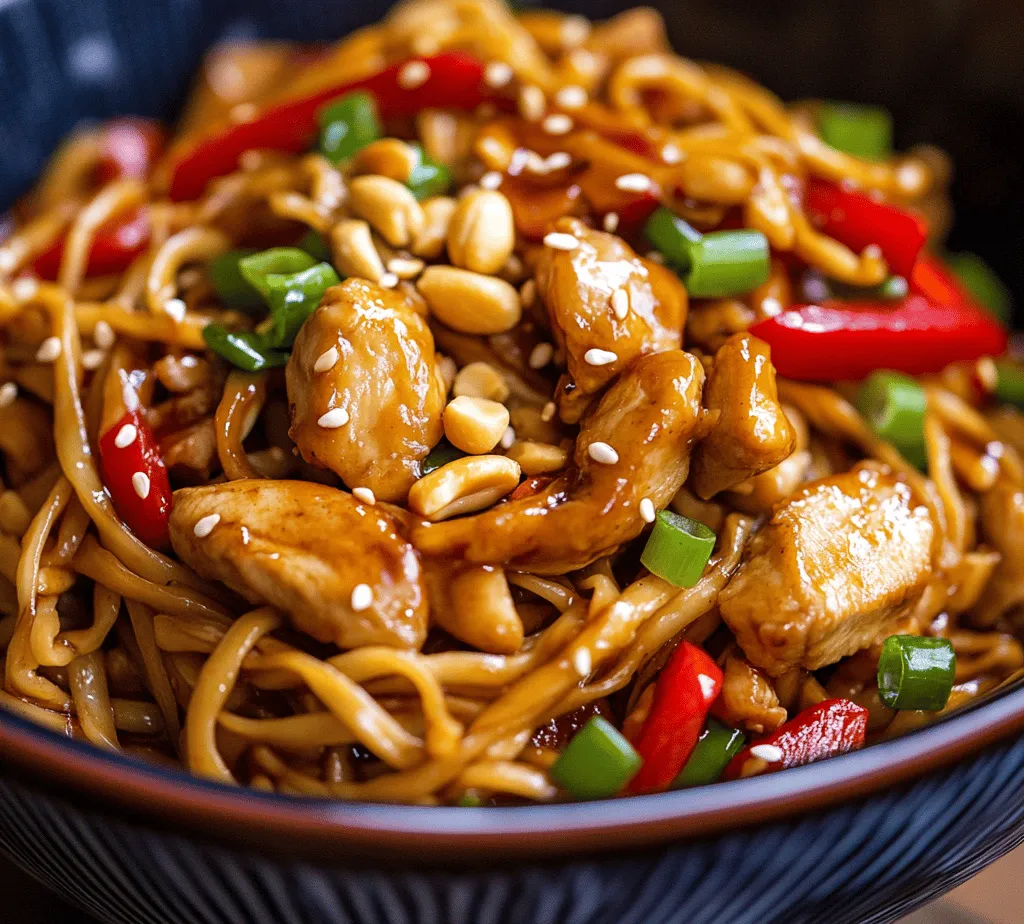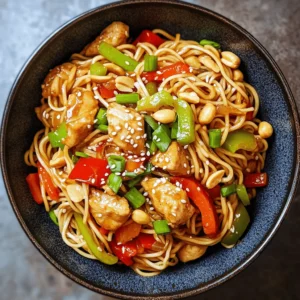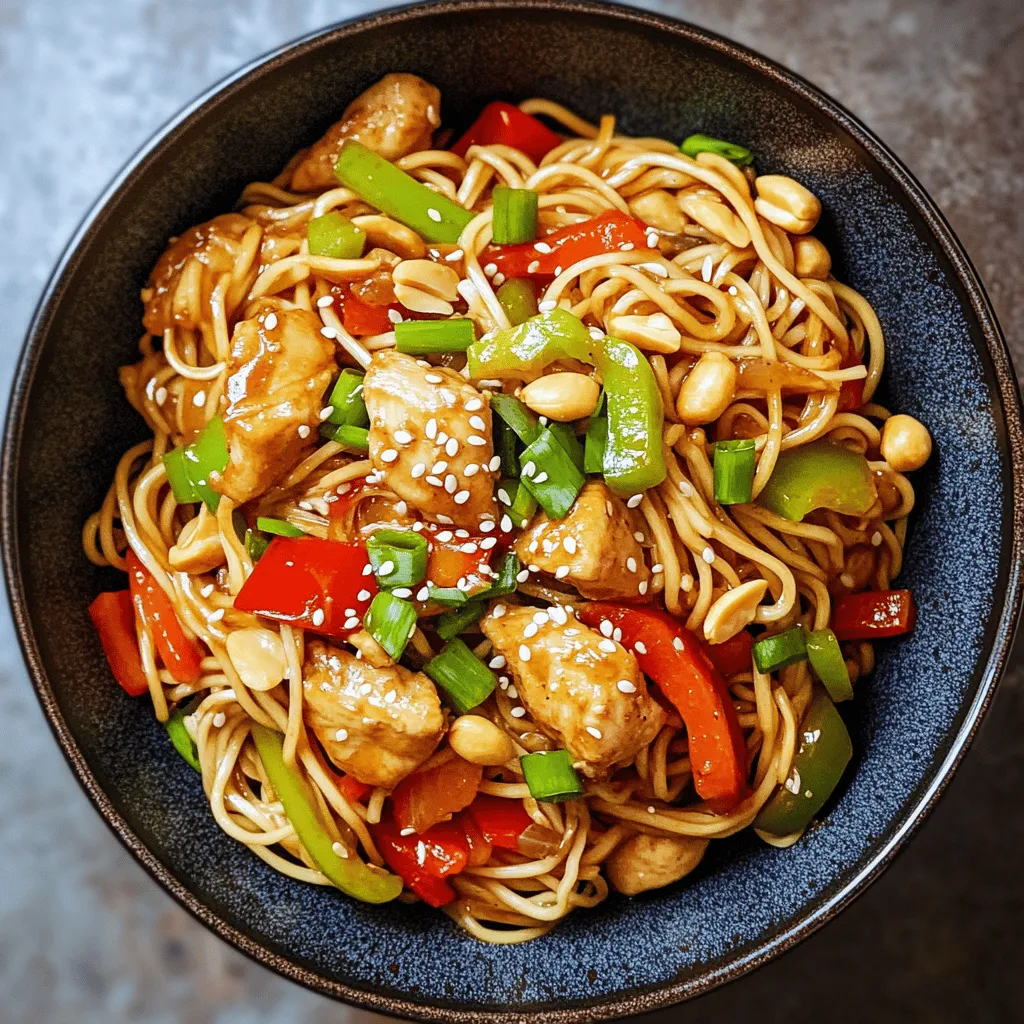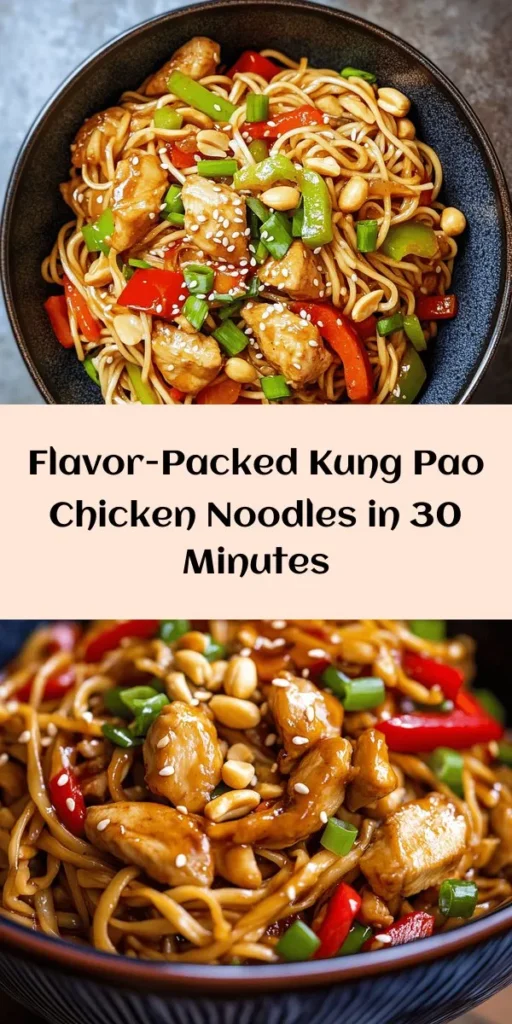Introduction
Kung Pao Chicken is a beloved dish that finds its roots deep within the rich tapestry of Chinese cuisine. Originating from the Sichuan province, this culinary masterpiece has captivated taste buds worldwide with its unique blend of flavors and textures. Traditionally, Kung Pao Chicken features diced chicken stir-fried with peanuts, vegetables, and a signature spicy sauce, creating a dish that is both savory and slightly sweet. However, in this recipe, we will take this classic dish to new heights by transforming it into Kung Pao Chicken Noodles—a delightful fusion that combines the essence of Kung Pao with the comforting appeal of noodles.
Kung Pao Chicken Noodles are not just a meal; they are an experience that tantalizes the senses. The combination of tender chicken, crunchy vegetables, and hearty noodles, all coated in a mouthwatering sauce, promises to deliver a satisfying dish that is perfect for any occasion. Whether you are hosting a dinner party, preparing a weeknight meal, or simply craving something delicious, this recipe is crafted to meet your needs.
To achieve the best results, the use of fresh ingredients is paramount. Fresh vegetables, quality chicken, and aromatic spices all contribute to the dish’s overall flavor profile, making every bite a joy. In the following sections, we will explore the historical significance of Kung Pao Chicken, delve into the essential ingredients that make this dish shine, and provide you with easy-to-follow steps to create your very own Kung Pao Chicken Noodles.
Understanding the Essence of Kung Pao Chicken
Historical Background of Kung Pao Chicken
Kung Pao Chicken, known as Gong Bao Ji Ding in Mandarin, has a storied history that dates back to the Qing Dynasty (1644-1912). The dish was named after Ding Baozhen, a governor of Sichuan province, who was fond of this particular recipe. Over time, Kung Pao Chicken evolved from a simple home-cooked meal into a staple in Chinese restaurants around the world. It is a prime example of how regional ingredients and cooking methods can culminate in a dish that transcends cultural boundaries.
The distinctive flavor profile of Kung Pao Chicken is influenced by the bold and complex tastes typical of Sichuan cuisine. This culinary style is renowned for its liberal use of spices, including Szechuan peppercorns, which impart a unique numbing heat that adds depth to the dish. The interplay of spicy, savory, and slightly sweet flavors creates a harmonious balance that is both satisfying and addictive.
Key Flavor Components: Spicy, Savory, and Slightly Sweet
The magic of Kung Pao Chicken lies in its carefully crafted flavor components. The spiciness often comes from dried red chilies, which can be adjusted based on your heat preference. The savory aspect is achieved through the use of high-quality soy sauce, which adds depth and umami to the dish. Lastly, the touch of sweetness can be derived from sugar or hoisin sauce, rounding out the flavors and making the dish irresistibly tasty.
In our Kung Pao Chicken Noodles recipe, these fundamental elements will be preserved while incorporating egg noodles, which absorb the sauce beautifully and add a satisfying chewiness to each bite. The result is a dish that pays homage to its roots while embracing the delightful textures of noodles.
The Role of Szechuan Cuisine in Shaping the Dish’s Identity
Szechuan cuisine is known for its bold flavors and innovative use of ingredients. The incorporation of peanuts in Kung Pao Chicken is a hallmark of this culinary tradition, providing a contrast in texture and a nutty flavor that complements the chicken and vegetables. Additionally, Szechuan cuisine often emphasizes the importance of balancing flavors, which is evident in Kung Pao Chicken’s combination of heat, saltiness, and sweetness.
As we adapt this classic dish into a noodle format, we remain true to the essence of Szechuan cuisine. The flavors and techniques remain intact, allowing you to experience a taste of authenticity with every forkful of Kung Pao Chicken Noodles.
Ingredient Breakdown
To create the perfect Kung Pao Chicken Noodles, we must select high-quality ingredients that not only contribute to the flavor but also enhance the overall dining experience. Below is a detailed breakdown of each ingredient and its role in this delicious recipe.
Chicken Breast
The cornerstone of any good Kung Pao Chicken dish is the chicken itself. We recommend using boneless, skinless chicken breast for its tenderness and ability to absorb flavors during marination. Chicken breast is a lean protein that cooks quickly and remains juicy when prepared correctly. For this recipe, cut the chicken into bite-sized pieces to ensure even cooking and easy consumption.
Vegetables
Fresh vegetables are essential for adding color, texture, and nutritional value to your dish. In our Kung Pao Chicken Noodles, we will use a combination of bell peppers, green onions, and garlic.
– Bell Peppers: These vibrant vegetables not only provide a sweet crunch but also a burst of color that makes the dish visually appealing. Red, green, and yellow bell peppers each bring their unique flavors, but feel free to use your favorites.
– Green Onions: Also known as scallions, green onions add a mild onion flavor and a pop of freshness. They can be sliced thinly and added both during cooking and used as a garnish for a vibrant finish.
– Garlic: Fresh garlic brings a rich aroma and depth of flavor that elevates the dish. It is best to mince the garlic finely or use a garlic press to maximize its impact.
Peanuts
Peanuts are a hallmark ingredient in Kung Pao Chicken, providing a delightful crunch and nutty flavor that complements the chicken and sauce. They also add healthy fats and protein, making the dish more satisfying. For added convenience, use roasted and unsalted peanuts, but you can also toast raw peanuts lightly in the pan for enhanced flavor.
Sauces
The sauces used in Kung Pao Chicken Noodles are what tie all the flavors together. The key sauces include:
– Soy Sauce: A staple in Asian cooking, soy sauce adds saltiness and umami depth to the dish. Opt for low-sodium soy sauce to control the salt level if desired.
– Rice Vinegar: This mild vinegar provides a hint of acidity that balances the richness of the chicken and peanuts. It also enhances the overall flavor profile, making each bite more enjoyable.
– Szechuan Sauce: This spicy sauce is essential for achieving that signature Kung Pao flavor. It usually contains chili paste, garlic, and a blend of spices. If you can’t find Szechuan sauce, a mix of chili garlic sauce and a dash of sesame oil can serve as a substitute.
Egg Noodles
Egg noodles are the perfect base for Kung Pao Chicken Noodles. They are tender yet sturdy, providing a satisfying chew that complements the chicken and vegetables. Available in various thicknesses, egg noodles cook quickly and can easily absorb the flavors of the sauce. You can find them fresh or dried in most grocery stores. Be sure to follow the cooking instructions on the package for perfect al dente noodles.
Nutritional Benefits
In addition to their deliciousness, the ingredients used in Kung Pao Chicken Noodles offer several nutritional benefits. Chicken breast is an excellent source of lean protein, supporting muscle growth and repair. Vegetables like bell peppers are packed with vitamins A and C, contributing to overall health and well-being. Peanuts provide healthy fats, protein, and essential nutrients like magnesium and vitamin E.
When combined, these ingredients create a balanced dish that is not only flavorful but also nourishing.
Preparation Steps for Kung Pao Chicken Noodles
With a better understanding of the ingredients and their roles in the dish, we can now dive into the preparation steps for Kung Pao Chicken Noodles. This section will provide you with a step-by-step guide to creating this delicious meal in your own kitchen.
Step 1: Cooking the Noodles
Begin by cooking the egg noodles according to the package instructions. To achieve the perfect al dente texture, follow these tips:
– Bring a large pot of salted water to a rolling boil before adding the noodles. The salt enhances the flavor of the noodles as they cook.
– Stir the noodles occasionally to prevent them from sticking together.
– Taste the noodles a minute or two before the suggested cooking time is up. They should be firm yet tender, maintaining a slight bite.
Once cooked, drain the noodles and rinse them under cold water to stop the cooking process. Toss them with a drizzle of sesame oil to prevent sticking and to add additional flavor.
Step 2: Marinating the Chicken
While the noodles are cooking, it’s time to marinate the chicken. Marinating is a crucial step that allows the chicken to absorb the flavors of the sauce and enhances its tenderness.
In a bowl, combine the diced chicken with a tablespoon of soy sauce, a teaspoon of rice vinegar, and a pinch of cornstarch. The soy sauce adds depth of flavor, while the rice vinegar brightens the mixture. The cornstarch will help create a velvety texture when the chicken cooks.
Allow the chicken to marinate for at least 15-20 minutes. If you have more time, marinating for up to an hour in the refrigerator will yield even better flavor and tenderness.
Step 3: Stir-Frying the Ingredients
Once the chicken has marinated and the noodles are ready, it’s time to stir-fry the ingredients. Heat a large wok or frying pan over medium-high heat and add a tablespoon of cooking oil. Once the oil is hot, add the marinated chicken in a single layer. Allow it to sear for about 3-4 minutes until it is cooked through and lightly golden.
After the chicken is cooked, remove it from the pan and set it aside. In the same pan, add another splash of oil if needed, and toss in the minced garlic, sliced bell peppers, and green onions. Stir-fry the vegetables for 2-3 minutes until they are vibrant and slightly tender.
Step 4: Bringing It All Together
Finally, return the cooked chicken to the pan with the vegetables. Pour in the Szechuan sauce, followed by a splash of soy sauce and a teaspoon of sugar to balance the flavors. Stir everything together, ensuring the chicken and vegetables are coated in the sauce.
Add the cooked egg noodles to the pan and toss everything together until the noodles are heated through and well-combined with the other ingredients. Toss in the roasted peanuts for that delightful crunch just before serving, and garnish with additional green onions if desired.
With these steps, you’ll have a delicious plate of Kung Pao Chicken Noodles ready to enjoy. Stay tuned for the next part of the article, where we will delve into tips for perfecting your dish and answer some common questions about this delectable recipe.

Stir-Frying Techniques: How to Achieve the Right Texture and Doneness
Stir-frying is a quintessential technique in Asian cooking that allows ingredients to cook quickly while retaining their flavor and texture. To achieve the perfect stir-fry for your Kung Pao Chicken Noodles, it’s essential to work with high heat and a few key practices.
1. Preheat Your Wok or Skillet: Start by heating your wok or large skillet over medium-high to high heat until it’s hot. A well-heated surface ensures that the ingredients sear rather than steam, preserving their natural crunch.
2. Use the Right Oil: Choose oils with a high smoke point, such as peanut oil, canola oil, or vegetable oil. These oils can withstand the high temperatures needed for stir-frying without burning, adding a subtle nuttiness to the dish.
3. Cook in Batches: If you’re making a large quantity, it’s better to cook your chicken in batches. Overcrowding the pan can lower the temperature, leading to boiling rather than stir-frying. This results in less desirable texture.
4. Timing is Key: Start with the protein, cooking the chicken until it is golden brown and cooked through, typically 4-5 minutes. Remove it from the pan and set aside. Follow with vegetables, stirring them quickly to maintain their crunch, which usually takes 2-3 minutes.
5. Add Ingredients in Order: Begin with denser vegetables like bell peppers and celery, followed by softer items such as scallions and garlic. This ensures that everything cooks evenly, achieving the desired doneness without compromising texture.
Balancing Flavors with Garlic and Ginger: Enhancing the Dish’s Aromatic Profile
Garlic and ginger are essential aromatics in Kung Pao Chicken Noodles, providing depth and complexity to the dish.
– Garlic: Use fresh garlic cloves, finely minced, and add them to the hot oil after the chicken has been removed. Sauté briefly until fragrant, but be careful not to let it brown, as burnt garlic can impart a bitter taste.
– Ginger: Fresh ginger adds a warm, slightly spicy note that complements the savory elements. Grate or finely chop the ginger and add it alongside the garlic. This combination will create a fragrant base that elevates the overall flavor profile.
By carefully balancing these aromatics, you create a foundation that enhances the dish, making it harmonious and appealing.
Incorporating Vegetables: How to Maintain Crunchiness While Ensuring Doneness
Vegetables play a crucial role in Kung Pao Chicken Noodles, providing texture and nutrition. Here’s how to ensure they remain crunchy while cooking through:
– Preparation: Cut your vegetables into uniform pieces to ensure even cooking. Bell peppers, carrots, and snap peas are excellent choices for this dish.
– Stir-Frying Method: Add vegetables to the hot wok or skillet in the order of their cooking time. Start with those that take longer to cook, like carrots, and follow with quicker-cooking ones like bell peppers and green onions.
– Quick Cooking: Aim for a stir-fry technique that cooks vegetables quickly while ensuring they’re still vibrant and crisp. A cooking time of 2-3 minutes should suffice, allowing the vegetables to retain their bright colors and crunch.
Final Assembly: Ensuring All Components Are Well Combined for a Harmonious Dish
Once all individual components are cooked, it’s time for the final assembly.
1. Combine Ingredients: Return the cooked chicken to the pan with the sautéed vegetables. Pour in the Kung Pao sauce, allowing it to coat everything evenly. Stir everything together, ensuring that the chicken and vegetables are well mixed.
2. Add Noodles: If you’re using pre-cooked noodles, add them to the mix. If you’re using fresh noodles, they can be added directly, ensuring they warm through and absorb the flavors from the sauce.
3. Final Toss: Give everything a good toss for about 1-2 minutes, ensuring the sauce clings to every ingredient and is well-distributed throughout the dish.
Flavor Enhancements and Customization
Kung Pao Chicken Noodles can be easily customized to suit various tastes and dietary needs. Here are some suggestions:
– Adjusting Spice Levels: For those who prefer milder flavors, reduce the amount of Szechuan peppercorns or omit them altogether. For a spicier kick, consider adding more crushed red pepper or chili paste to the sauce.
– Ingredient Substitutions: For gluten-free options, replace soy sauce with tamari or coconut aminos. If you’re looking for a lower-carb option, swap noodles for spiralized zucchini or cauliflower rice.
– Vegetable Variations: Feel free to experiment with different vegetables like broccoli, bok choy, or mushrooms. Each brings unique textures and flavors, adding diversity to your dish.
– Alternative Proteins: For a vegetarian or vegan version, substitute chicken with tofu. Firm tofu can be diced and sautéed until golden, providing a satisfying protein source that absorbs the Kung Pao flavors beautifully.
Serving Suggestions
To elevate your Kung Pao Chicken Noodles experience, consider the following serving suggestions:
– Ideal Pairings: This dish pairs wonderfully with a simple side of steamed broccoli or a light cucumber salad. For drinks, a chilled jasmine tea or a crisp lager complements the meal perfectly.
– Presentation Tips: To enhance visual appeal, serve your Kung Pao Chicken Noodles in a large bowl, garnished with sesame seeds and thinly sliced green onions. The garnish not only adds a pop of color but also contributes additional flavor.
– Portion Sizes: When serving for family meals or gatherings, consider portioning out the noodles into individual bowls or plates. This makes it easier for guests to enjoy, and you can serve additional sides for a complete meal.
Nutritional Information
Understanding the nutritional content of your Kung Pao Chicken Noodles can help you appreciate its health benefits:
– Caloric Breakdown: A typical serving (approximately 1.5 cups) contains around 450-500 calories, depending on the specific ingredients and portion sizes used.
– Macronutrients:
– Protein: About 25 grams from chicken and any added tofu.
– Fats: Approximately 15 grams, primarily from oil and any nuts used.
– Carbohydrates: Roughly 60 grams, coming from noodles and vegetables.
– Health Benefits: The ingredients used in Kung Pao Chicken Noodles offer numerous health benefits. For example, chicken provides lean protein, while vegetables contribute essential vitamins and fiber. Garlic and ginger are known for their anti-inflammatory properties, and the use of nuts adds healthy fats.
– Balanced Diet Compatibility: This dish can fit into a balanced diet when enjoyed in moderation. It provides a good mix of macronutrients while also offering a hearty serving of vegetables, making it a wholesome meal option.
Conclusion
Making Kung Pao Chicken Noodles at home is a rewarding culinary experience that brings together vibrant flavors and textures. The joy of preparing this dish lies not only in the cooking process but also in the satisfaction of enjoying a homemade meal that celebrates flavor and tradition.
As you experiment with this recipe, feel free to make it your own by adjusting spice levels, incorporating alternative proteins, or adding your favorite vegetables. The flexibility of this dish allows you to tailor it to your palate and dietary needs.
In the end, Kung Pao Chicken Noodles remind us of the joy of sharing a delicious meal with family and friends, and there’s nothing quite like the satisfaction of serving a dish that you crafted from scratch. So gather your ingredients, follow the steps, and embark on a delightful cooking adventure that will leave everyone asking for seconds!



